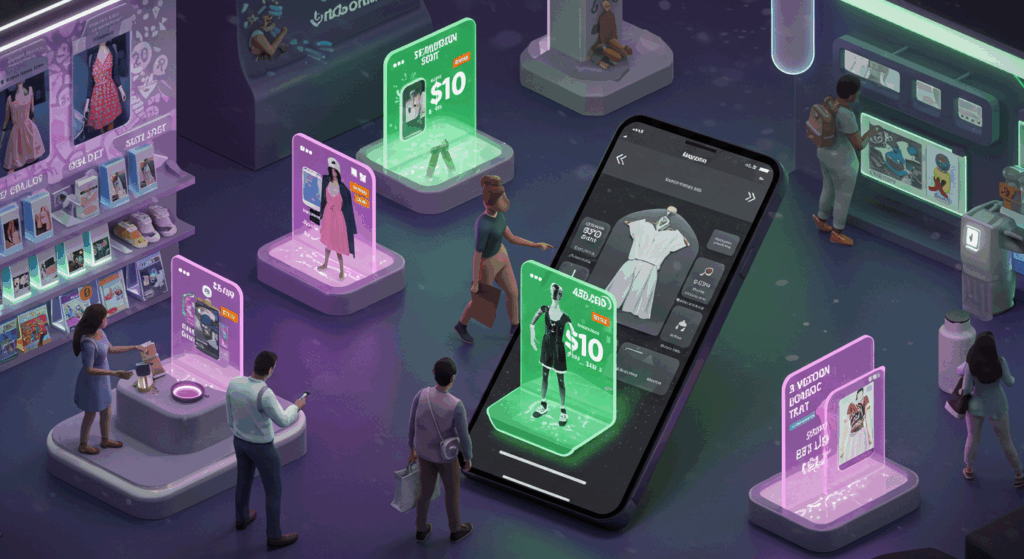In 2025, Amazon Haul is transforming global shopping with its ultra-low-priced products, challenging giants like Temu and Shein. Launched in the USA and eyeing expansion to Europe and Mexico, this mobile-first storefront offers fashion, electronics, and home goods—all under $20. For example, NovexaHub takes a documentary-style approach to explore this budget-friendly revolution. Curious about how Amazon Haul operates, who’s shopping it, or its impact on e-commerce? Let’s dive into the low-cost shopping wave sweeping 2025.
A Game-Changer: The Rise of Amazon Haul in 2025

Picture finding a $2.99 phone case or a $5.99 table runner with just a tap. Amazon Haul, launched in November 2024 as a beta, makes this possible by offering products priced at $20 or less, most under $10. Unlike Amazon’s main store, however, Haul prioritizes slower shipping (one to two weeks) to keep costs down, sourcing directly from manufacturers, often in China. In addition, Amazon’s Haul page highlights its A-to-Z Guarantee, ensuring safe purchases.
Why is this significant? Haul taps into the demand for affordable shopping, leveraging Amazon’s trusted infrastructure. Its popularity surges in the USA, with Europe next in 2025. Moreover, our Global Tech Trends 2025 article explores similar retail shifts.
Features That Define Amazon Haul
- Ultra-Low Prices: Everything $20 or less, most under $10.
- Diverse Categories: Fashion, electronics, home goods, and more.
Crafting the Experience: How Amazon Haul Works

Browsing Amazon Haul feels like a treasure hunt. The platform operates as a separate storefront within Amazon’s ecosystem, with a dedicated cart and checkout. For instance, shoppers discover influencer-led “fashion picks” or “Deep Cuts” branded items discounted up to 80%. Orders over $25 qualify for free shipping, but smaller orders incur a $3.99 fee. According to Forbes, delivery takes one to two weeks, a trade-off for unbeatable prices.
How does this engage users? The thrill of deals, combined with Amazon’s reliability, draws cost-conscious shoppers in the USA and Canada. In contrast, our Smart Cities 2025 article examines tech-driven retail innovations.
What Makes Haul Stand Out
- Curated Finds: Influencer storefronts and branded discounts.
- A-to-Z Guarantee: Ensures safe, authentic products.
Stories from Shoppers: Real-Life Amazon Haul Experiences

Ever wondered what it’s like to shop Amazon Haul? Emily, a 27-year-old teacher from Texas, USA, discovered Haul in 2025. “I snagged a $3.99 velvet dress and a $2.99 phone case,” she shares. “For example, the quality blew me away for the price. My TikTok haul video hit 50,000 views!” Meanwhile, Carlos, a 34-year-old designer in London, UK, awaits Haul’s European launch. “I’ve seen USA reviews on X,” he says. “In addition, the $7.99 neon moon light is on my list.”
These stories reveal Haul’s growing buzz, particularly in the USA. However, our Tech Trends 2025 article dives deeper into consumer behavior.
Tales of Deals and Discovery
- Emily’s Find: A viral velvet dress for $3.99.
- Carlos’ Anticipation: Eager for Haul’s UK debut.
Building a Brand: The Power of Amazon Haul’s Model
Amazon Haul blends low-cost imports with Fulfillment by Amazon (FBA), dodging tariffs hitting rivals like Temu. Sponsored ads and influencer storefronts, such as Michaela Delvillar’s TikTok picks, amplify engagement, driving Amazon’s $56.2 billion ad revenue in 2024. Furthermore, CNBC reports Haul’s beta now includes branded items, appealing to diverse shoppers.
Why does this succeed? Haul balances affordability and trust, a trend spreading to Australia and Mexico. For instance, our Cybersecurity Trends 2025 article explores e-commerce security.
Features Driving Success
- Hybrid Model: Unbranded and branded items at low prices.
- Influencer Boost: Curated picks amplify engagement.
Society and Ethics: The Debate Around Amazon Haul
Amazon Haul’s rise isn’t without controversy. Critics, like Forrester’s Sucharita Kodali, argue it fuels overconsumption and environmental waste, akin to Temu and Shein. On the other hand, supporters highlight its affordability amid economic challenges. According to The New York Times, Amazon’s Dr. Maria Boschetti defends Haul as a response to deal-hungry shoppers. Nevertheless, domestic warehousing may give Haul a tariff edge.
What fuels this debate? Balancing affordability with sustainability resonates in the UK and Canada. In contrast, our Sustainable Living Guide tackles ethical tech issues.
Benefits and Challenges
- Advantages: Affordable shopping with trusted delivery.
- Concerns: Environmental impact and overconsumption.
The Shopping Process: Navigating Amazon Haul
Getting started with Haul is a breeze. Shoppers download the Amazon app, search “Haul,” or visit amazon.com/haul. For example, add items to Haul’s dedicated cart and unlock discounts—5% off $50+, 10% off $75+. Returns are free for items over $3 within 15 days, though “Final Sale” items ($3 or less) are non-returnable. Moreover, Investopedia notes Haul focuses on treats, like toothbrush holders, not essentials.
Why is this engaging? The gamified deal-hunting experience captivates users in the USA and Japan. In addition, our Tech Learning Guide offers more shopping tips.
Steps to Shop Haul
- Access: Search “Haul” in the Amazon app or online.
- Deals: Unlock discounts with larger orders.
Looking Ahead: Amazon Haul’s Global Future

Expansion is on the horizon for Amazon Haul. Job postings suggest a 2025 rollout in Europe and Mexico, while X posts hint at more US-warehoused branded items to avoid tariffs. By 2026, Haul could adopt faster shipping or TikTok Shop-style social features, as per Forbes. Consequently, Haul may redefine budget e-commerce globally.
What does this mean? Haul’s growth excites shoppers in the UK and Australia. For example, our Smart Cities 2025 article explores retail’s future.
Innovations on the Horizon
- Global Reach: Europe and Mexico launches in 2025.
- Social Shopping: Potential TikTok-style integrations.
Practical Advice: Getting the Most Out of Amazon Haul
To get the most from Haul, bundle orders to hit $25 for free shipping. Additionally, check influencer storefronts for curated deals and avoid “Final Sale” items unless certain. Monitoring X for user reviews helps, as quality varies. Finally, keep the Amazon app updated for new features, as advised in Amazon’s FAQ.
How does this help? These tips ensure smarter shopping, buzzing in the USA and Canada. For instance, our Tech Learning Guide shares more practical advice.
Tips for Smart Shopping
- Bundle Orders: Reach $25 for free shipping.
- Check Reviews: Use X for real user feedback.
Global Perspectives: How the World Views Amazon Haul
Amazon Haul’s global reception varies in 2025. The USA embraces it, with Amazon’s 236.1 million monthly visitors. However, France’s regulators scrutinize fast-fashion’s environmental toll, potentially delaying Haul’s EU debut, per LSA Conso. Japan loves its deal-driven model, while the Middle East remains cautious. Consequently, cultural and economic factors shape adoption.
What drives these differences? Global shopping trends, as explored in our Global Tech Trends 2025.
How Countries React
- USA: A deal-hunting haven.
- France: Wary of fast-fashion impacts.
The Bigger Picture: Why Amazon Haul Matters in 2025
Amazon Haul is more than a discount store—it’s a shift in how we shop, blending affordability with Amazon’s trust. Whether it’s empowering budget shoppers or sparking debates on sustainability, Haul is reshaping e-commerce. As it goes global, the conversation around low-cost shopping is just beginning, and Amazon Haul is leading the charge.
What do you think about Amazon Haul’s rise in 2025? Share your thoughts in the comments below! For more tech and lifestyle insights, keep following NovexaHub—your guide to the future!

